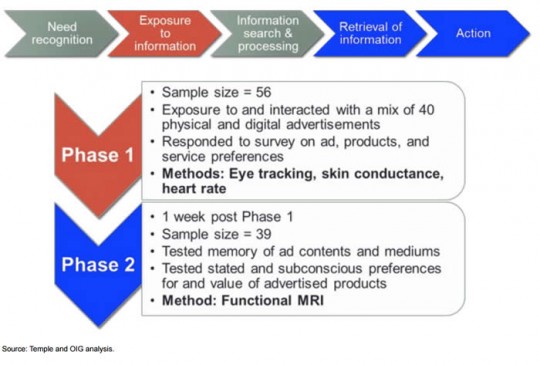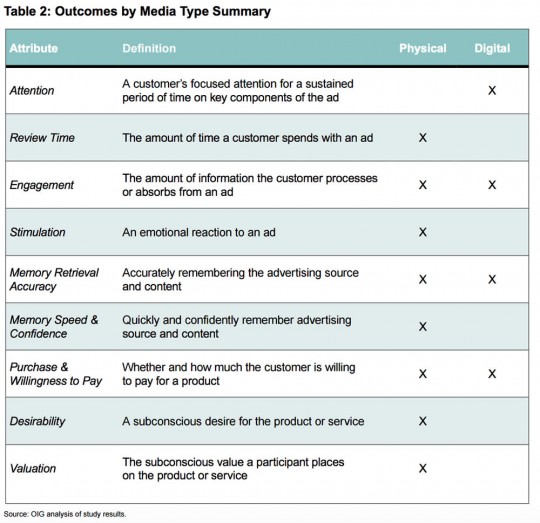Print vs. Digital: Another Emotional Win for Paper

Every year, consumers spend more time using digital devices. Every year, more media is consumed digitally. Naturally, advertising dollars are increasingly flowing to digital as well. But, don’t pull the plug on that direct mail campaign just yet. New research has again shown that content on paper affects our brains in different and more powerful ways.
The latest findings come from Temple University consumer neuroscience researchers. In a study conducted for the U.S. Post Office, they found significant differences in the way our brains process the two ad formats.
Test Methods

The scientists had subjects view ads via either digital or physical media. They used a variety of neuromarketing methods, including eye tracking and biometric measurements, to gauge the initial reactions.
A week later, many of the same subjects were put in an fMRI machine to evaluate the longer-term impact of the ads.
At several points in the process, the scientists also used traditional questionnaires to gather comparison data. The link above includes photos of the physical ad displays and experimental setup.
What They Found
Here’s a tabular summary of the results prepared by the Postal Service Office of Inspector General (OIG), who commissioned the study – the “x” indicates the medium which performed better:
Some of the interesting findings are:
- Digital ads were processed more quickly.
- Paper ads engaged viewers for more time.
- Subjects reported no preference for either medium.
- Subjects absorbed about the same amount of information from both media.
- A week later, subjects showed greater emotional response and memory for physical media ads.
- Physical ads caused more activity in brain areas associated with value and desire.
In a previous series of experiments, the same Temple researchers showed that the the ventral striatum was the brain structure whose activity was most predictive of future purchasing behavior. (See Neuromarketing: Pseudoscience No More and my podcast, Scientists Get Closer to The “Buy Button” in The Brain with Angelika Dimoka, Paul Pavlou and Vinod Venkatraman.)

Notably, the latest set of experiments showed that physical media caused greater activation of the ventral striatum than digital media. While this doesn’t conclusively show that paper is more powerful than digital for stimulating intent to purchase, it is a finding worth exploring in more detail.
Brain scans: print ads lit up 'purchase intent' area more than digital. pic.twitter.com/Kc1KVhBCIY Share on XPaper vs. Mobile?
The experimental setup in these experiments used a large monitor screen for the digital ad display. Today, though, both media consumption and shopping are shifting from laptop and desktop computers to mobile devices.
For me, the mobile experience is quite different than the experience on a bigger screen. And apparently it’s not just me. An New York Times article earlier this week discusses how ecommerce firms are trying to create a mobile experience that is as user-friendly as the computer. One typical consumer they quote said,
“There’s just always something, if it’s your fat thumbs or having to redo your information. I go straight to the desktop because I feel like it’s going to be easier.”
I’d love to see a similar set of experiments conducted to compare the small-screen experience to paper media. It wouldn’t be surprising if the paper vs. digital gap widened when images are much smaller and the field of view is limited.
Marketing Takeaway
There are opposing forces at work here. Marketers want to use the most effective and impactful medium, but also have to focus efforts on those media that consumers are using most. Even if we believe print ads are potentially more powerful, we have to acknowledge the massive shift to mobile devices for many daily activities.
In many cases a mix of media will be the best solution. Effective print ads will drive digital purchases. I love flipping through the richly illustrated Charles Tyrwhitt catalogs, but if I decide to place an order I’ll jump on my computer. While I’m there, I might use the site search feature to look for short-term specials or items not in the paper catalog.
The product itself makes a big difference in determining how to allocate media budgets.
If I’m browsing fine home furnishings or custom shirts, a large-format catalog will provide an experience that is more enjoyable and useful. Big, beautiful magazines like Condé Nast Traveler or Wine Spectator provide a more relaxed and luxurious way to explore both content and upscale products.
I’d contrast those desirable print vehicles with a shipping supplies catalog I (for unknown reason) receive regularly. This is a thick, heavy phone book-size catalog that can run well over 600 pages. It’s not a bad catalog, and it’s certainly comprehensive, but the products don’t generally need amazing illustrations. A utilitarian photo is fine. And, from a usability standpoint, I’m quite certain I could find a product faster on a search-enabled website than in a 664-page book.
Perhaps the shipping supply company knows their customers, and many of them prefer to shop by flipping pages. Or, maybe those customers are so excited by shipping that they actively enjoy looking at innumerable variations on the cardboard box.
For me, that costly print catalog doesn’t add much value.
Based on the new research as well as my own experience, I’d use print more heavily for things like fashion, luxury items, distinctive brands, etc. Not only will print be able to communicate the unique properties of the offering, it will allow greater emotional impact to drive purchases.
Print will be less important for utilitarian purchases, for example:
- Low-emotion products (e.g., office supplies)
- Categories with many SKUs (e.g., printer ink)
- Items where distinctive branding is less important
- Items that don’t benefit from compelling images
These and similar areas can be served effectively by well-designed digital interfaces that let customers quickly find and, if appropriate, compare products.
Even where print remains an important medium, of course, an exceptionally good digital experience is necessary both to complete print-driven sales and originate sales independently. I can’t think of a worse waste of money than distributing a gorgeous print catalog and then losing sales because of a confusing online checkout process.
Study shows print ads top digital for emotion & desire. pic.twitter.com/k0ST2tk283 Share on X

